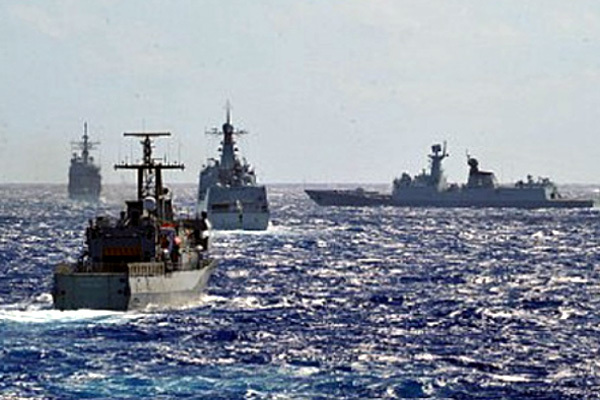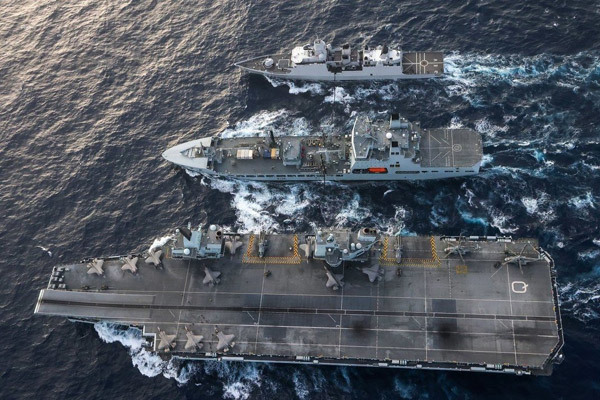On the 100th anniversary of the Chinese Communist Party's founding, Beijing declared: The era in which China was massacred, bullied and humiliated has been gone; China can not only break down an old world, but also create a new one, and warn others not to underestimate the Chinese people's unyielding determination, steadfast will and great strength in protecting national sovereignty and territorial integrity.
The Chinese National People’s Congress approved the 14th Five-Year Plan, affirming the goal of "intensifying research and legal fighting, strengthening the construction of maritime jurisdictions, resolutely safeguarding the maritime rights and interests of the country”.
Legalization of entire East Sea
 |
|
China increases the presence of its coast guard vessels inthe East Sea. |
China is showing a trend of internalizing the entire East Sea, aiming to comprehensively deploy three types of tactics to create a legal basis and propaganda.
Specifically, Beijing issues national documents claiming maritime areas that are not in accordance with international law; internalizes and imposes internal regulations and administrative measures to assert sovereignty and sovereign rights in the East Sea; and on a legal basis created by domestic law, it takes measures to control and master the field.
When they are protested, they have a legal basis to be willing to use or threaten to use force to prevent other countries' activities in areas within the "waters under national jurisdiction", to put pressure on countries with claims in the East Sea to cooperate in favor of China.
In order to expand the law enforcement powers of its maritime law enforcement and handle activities of other countries in the East Sea that are considered violating the waters under its jurisdiction, China announced the so-called Certificate of Law Enforcement of China's Coast Guard, revised regulations on ocean fisheries management, China's maritime management and supervision mechanism, amended National Defense Law, Coast Guard law, amended Maritime Security Law.
These laws go along with the "Tu Sa" (Four Sha) claim, administrative documents: "Standard names of 25 islands and rocks in the East Sea"; and “55 geographical features on the bottom of the East Sea”; The establishment of the so-called "Xisha district" and "Nansha district" under Sansha city, Hainan province promulgated in 2020 as a basis for strengthening China's presence in the East Sea.
The Coast Guard Law, effective from February 1, 2021 and the revised Law on Maritime Security, effective September 1, 2021 both allow the application of coercive measures, including the use of force, against foreign ships violating the waters under the jurisdiction of China.
This concept has never been defined by law and has been interpreted vaguely, on the basis of the nine-dash line claim, and the Four Sha claim, which covers over 80% of the East Sea, so it causes concern for the international community.
 |
|
China exercises in the East Sea. Photo: Sina
|
After illegally expanding the low-tide elevations in Truong Sa Archipelago (Spratlys) of Vietnam into military bases, China began to increase the size and frequency of presence of coast guard ships, maritime scientific research and maritime militia in the East Sea. Its vessels continuously enter the waters of Vietnam, the Philippines, Malaysia and Indonesia.
In addition to the coast guard ships, China for the first time sent 16 aircraft to the flight information area (FIR) managed by Malaysia. The frequency of exercises has also increased significantly in Vietnam's Hoang Sa and Truong Sa, especially the landing drills to occupy islands. In the first half of 2021, China conducted 26 maritime exercises (an increase of nearly three times compared to the same period of 2020), 22 exercises in the air, five more than the same period in 2020, 17 over the same period in 2019, 21 over the same period in 2018.
In August 2021, there were four major exercises in response to the Quadrilateral Security Dialogue (QUAD)'s activities off Guam. China's maritime militia regularly congregated on unoccupied features in the Spratlys such as the Ba Dau (Whitsun Reef) incident. Its third aircraft carrier is expected to be completed early this year, increasing the strength of the Chinese Navy in the East Sea.
 |
|
The Malaysian Air Force in May 2021 detected a group of 16 Chinese aircraft close to the coast of Borneo, in the eastern Malaysian state of Sarawak. Photo: THX |
Reactions of ASEAN countries
The year 2021 marked a "tougher" attitude from ASEAN countries. Malaysia made a diplomatic response to the 16 Chinese aircraft entering the Malaysian FIR one day after the incident, and it reacted to China’s sending of vessel HD-8 to Malaysia's exclusive economic zone in 2020 after one week. Malaysia also publicly summoned the Chinese Ambassador to protest the presence of Chinese ships in its waters.
Brunei first published its Defense White Paper after 10 years, mentioned the United Nations Convention on the Law of the Sea (UNCLOS) for the first time and repeated 10 times the phrase "rule-based international/global order". The Philippines also returned to affirm the validity of the PCA ruling and the extended Visiting Forces Agreement (VFA) that regulates the presence of US troops in the Philippines.
Notably, the Philippines brought the value of the PCA ruling to the United Nations General Assembly meeting in September 2021 and strongly reacted to Xi Jinping's statement on November 28 and protested Chinese coast guard ships using water cannons to attack their supply ships in Truong Sa (Spratlys).
However, ASEAN has not yet expressed a common stance that goes beyond the ASEAN Chairman's statements made at the 36th and 37th sessions in 2020.
COC and prospects
The Code of Conduct in the East Sea (COC) is a collective initiative of ASEAN to prevent extended conflict. However, recent negotiations show that ASEAN is gradually losing its initiative in negotiating the COC. China is the one that shapes the game, sets the end time and the content.
The Special Meeting of Foreign Ministers of ASEAN - China held in Chongqing, China on June 7, 2021 to celebrate the 30th anniversary of the partnership issued a statement: "ASEAN and China are committed to accelerating the resumption of negotiations of the COC through online forms, towards the early completion of a substantive, effective COC, in accordance with international law.”
The meeting affirmed its determination to complete the 3-year roadmap for COC negotiations (2018-2021) regardless of the impact of the Covid-19 pandemic.
During a visit to Cambodia in September 2021, Chinese Foreign Minister Wang Yi hinted at the possibility of concluding negotiations in 2022 in Phnom Penh, where the Declaration on the Conduct of Parties in the East Sea (DOC) was signed 20 years ago.
Detailed proposals to control the excessive behavior of the parties in the East Sea were rejected when China believed that the situation in the East Sea was still under control and always maintained two new proposals: oil and gas exploration and development activities in disputed waters can only be carried out by the countries bordering the East Sea without the cooperation of foreign companies. Parties to the COC may not conduct military exercises with foreign countries unless the countries concerned are informed and do not object.
These proposals clearly do not respect the maritime sovereignty and jurisdiction of countries in the East Sea, forcing them to accept "putting aside disputes and jointly exploiting" in their own waters, accepting the deployment of military forces and the presence of Chinese companies in all areas of maritime activities in the East Sea, thereby reducing the influence of countries outside the region and negating military exercises by countries in the region with the US, Japan, Korea, India.
Malaysia responded, saying that "the COC must not affect the rights and ability of the parties to conduct activities with other countries or with private companies of their choice".
India requires the participation of third countries in the COC negotiation process. To achieve a substantive and effective COC, ASEAN needs to take an independent and strong stance. ASEAN needs to show its central role when more and more new international mechanisms such as QUAD, AUKUS appear or China's participation in the CPTPP.
Nguyen Hong Thao

Five years of PCA's ruling: no such thing as ‘power creating justice’
The Permanent Court of Arbitration (PCA)'s ruling has been an irrevocable part of history. It will act as a “guide” for countries involved in the struggle for an order based on rules and not on “force creating justice.”

The East Sea in US-China competition in 2021
The year 2021 was a turning point year in competition in the East Sea, between the countries inside and outside the region and China.